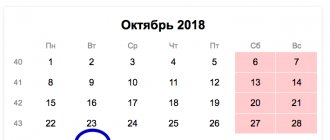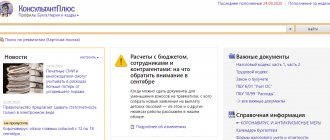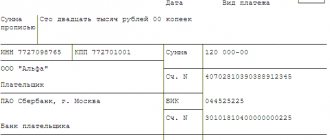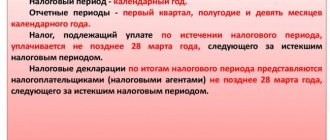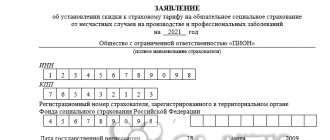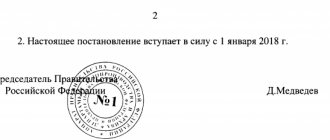RSV - what is this form? Who should submit the report and when?
RSV is a quarterly report on insurance contributions of all types: pension, social and medical insurance.
The report is submitted by all organizations and entrepreneurs who are policyholders, even if they do not regularly pay contributions for their employees. The type of contract is not important: employees under a contract are accountable for in the same way as employees under an employment contract.
Organizations, separate divisions and branches report to the tax office at the place of business or accounting.
Please note that from January 1, 2021, amendments to the Tax Code introduced by Federal Law No. 325-FZ of September 29, 2019 are in effect. According to the new edition of paragraph 7 of Article 431 of the Tax Code, separate divisions submit calculations at the location of the separate divisions of the organization for which the organization has opened bank accounts and which accrue and make payments and other remuneration in favor of individuals.
Individual entrepreneurs and self-employed citizens submit calculations to the tax office at their registration address.
It is also important to know that from January 1, 2021, insurers with more than 10 people are required to submit calculations electronically (amendments to Article 431 of the Tax Code of the Russian Federation were introduced by Federal Law No. 325-FZ of September 29, 2019).
Even if you did not make contributions for employees during the reporting period, still submit the calculation to the tax office. This is necessary so that you are not considered late and are not charged a fine. To do this, fill out the required sections of the calculation and submit the tax zero form.
The deadline for submission is established by the Tax Code of the Russian Federation - the 30th day of the month following the reporting period. In 2021, the DAM must be submitted within the following deadlines:
| Reporting period | Deadline for submission (2020) |
| 2019 | January 30 |
| I quarter 2020 | April 30 |
| 6 months 2020 | July 30 |
| 9 months 2020 | October 30 |
On the DAM, general transfer rules apply. Therefore, if the last day of delivery falls on a weekend or holiday, the deadline is extended to the next working day. There will be no such shifts in 2021.
Prepare and send a calculation of insurance premiums via Kontur.Extern.
Send a request
If the policyholder submits the report later than the due date, he will be fined. The fine is equal to 5% of the contributions reflected in the report. It is charged for each full and partial month of delay. At the same time, you will not be able to pay a fine of less than 1,000 rubles, but you will not be punished for more than 30% of the contributions.
Another trouble that awaits latecomers is the blocking of their current account. The tax office has the right to block it for being late by more than 10 working days.
Calculation of insurance premiums in 2021 | Example of filling according to the DAM 2021 model - Kontur.Accounting
All organizations and individual entrepreneurs with employees submit calculations for insurance premiums. We will tell you when the calculation is due, where it is sent, whether it can be submitted on paper and whether to submit a “zero” calculation. We will also show you a sample of how to fill out the report.
Who submits the RSV
All employers submit calculations for insurance premiums: organizations and separate divisions, individual entrepreneurs, farmers and individuals without individual entrepreneur status. Be sure to submit a calculation if you have insured persons:
- employees registered under employment contracts;
- employees registered under civil law contracts (contractor agreement, service agreement);
- director of the organization, even if he is the only founder.
If the employer did not pay wages in the reporting quarter, he is still required to submit a report in zero format - the title page and empty sections 1, 1.1, 1.2 and 3. If the report is not submitted, the tax office will impose a fine of 1,000 rubles.
When and where to submit insurance premium payments
RSV - quarterly report to the tax office. Submit your payment no later than the 30th day of the month following the reporting period. The reporting periods for insurance premiums are quarterly, half-yearly, nine months and calendar year.
The calculation we submit includes indicators from the beginning of the year to the end of the reporting quarter. That is, the DAM for the second quarter includes data for six months, and for the third quarter - data for 9 months of 2019.
The deadlines for submitting calculations are as follows:
- 1st quarter - April 30, 2020;
- 2nd quarter (half year) - July 30, 2020;
- 3rd quarter (9 months) – October 30, 2020;
- for the 4th quarter (2020) - February 1, 2021.
If the delivery day falls on a weekend or holiday, the due date is postponed to the next closest working day.
The day on which you submitted the report to the tax inspector and received the acceptance stamp on the second copy is considered the day the calculation is submitted. When sent by mail, the day the post office accepted the package and stamped it. When sending by telecommunications - the day on which your TCS operator recorded the sending of the calculation.
Individual entrepreneurs submit their calculations to the tax office at their place of residence. Organizations and separate divisions that pay salaries to employees or performers report at their location.
Payment methods
Since the beginning of 2021, there have been changes in the methods of submitting calculations - the number of employees for submitting paper calculations has been reduced.
It can be submitted on paper “by hand” to the tax office or by mail, but only if the average number of employees for the reporting period is not more than 10 people. Otherwise, the company faces a fine for violating the format.
If in the last reporting period the average number of employees was more than 10 people, submit an electronic payment via the Internet using an enhanced qualified electronic signature.
In 2021, the limit was set for employers with 25 employees.
Do I have to take zero marks?
The calculation must be submitted even if no activity was carried out during the reporting period. The absence of activity and payments to individuals, the absence of movements on accounts does not cancel the obligation to submit settlements. It’s just that in such a situation a zero calculation is submitted to the tax office.
Fines for violations when submitting payments
For violation of the delivery format, when an organization with more than 10 employees submits calculations on paper, the tax office imposes a fine of 200 rubles.
If errors are made in the calculation (incorrect personal data or discrepancies in indicators), the tax office will send a notification of errors with a request to correct the calculation.
The policyholder has 5 business days from the date the electronic notice is sent or 10 business days from the date the paper notice is sent to send an adjusted estimate.
If these deadlines are violated, the calculation will be considered unsubmitted, which will result in a fine of 5% of the amount of contributions due.
If the payment is late, the tax office will fine the policyholder for each full or partial month of delay in the amount of 5% of the premiums payable. The total amount of the fine cannot be less than 1,000 rubles and more than 30% of the amount of contributions payable. For failure to submit a zero report, the fine will be 1,000 rubles.
New RSV form from April 1, 2021
The calculation form for insurance premiums in 2021 was updated by order of the Federal Tax Service of the Russian Federation dated September 18, 2019 No. ММВ-7-11/ [email protected] The form has a KND number - 1151111. Detailed instructions for filling out the DAM are in Appendix No. 2 to the order. Filling out the form will require accuracy and attention, since errors in the calculation can lead to fines and the need to re-submit the DAM.
The main changes in the calculation affected the design of the form. It has become simpler and reduced by almost 1/3. Let's look at the innovations in more detail:
- Title page. Fields have appeared for information about separate divisions that were closed or deprived of authority.
- The sheet with data for citizens without a registered individual entrepreneur has been removed. Now they submit reports according to the same rules as entrepreneurs.
- The “Payer type” field has been added to section 1 Those who made payments to individuals during the last quarter put “1”, those who did not make payments put “2”. The lines for calculating the total amounts of contributions payable have been removed. Instead of subsection 1.4, Appendix No. 1.1 was added to the first section.
- In Appendix 2, the field “Payer Tariff Code” and the line “Number of individuals from whose payments insurance premiums were calculated” were added.
- In subsections 1.1 and 1.2, lines have been added for deductions under copyright agreements or intellectual property agreements.
- In subsection 1.3.2 it is no longer necessary to indicate the code of the reasons for filling out the calculation. The danger of workplaces is classified based on the results of a special assessment.
- In Appendix 1 to Section 2, farmers are required to indicate the identification code and data from it. If a peasant farm has several chapters, then information is entered for each.
- In section 3 , field 010 was added with a sign of cancellation of information about the insured. It is filled out when an employee’s personal data needs to be cancelled.
How to fill out the RSV
Fill out the fields in the calculation from left to right, starting with the first acquaintance. Indicate monetary amounts in rubles and kopecks. If you fill out the calculation manually, use blue, black or purple ink.
If there are no indicators, put zeros (for amounts) or dashes (for text) in the cells.
If you fill out the calculation on a computer, use capital block letters, Courier New font size 16-18; if there are no indicators, there is no need to put dashes and zeros.
Those dismissed in the DAM report are indicated in section 3 of the calculation: it lists all persons in whose favor payments were made in the reporting period and employees dismissed in the previous reporting period. The attribute of the insured person for dismissed employees “1” must also be indicated.
After filling out the calculation, number the pages consecutively, regardless of the absence of sections to be filled in or their number. At the end of the article we provide a sample of a completed calculation for an organization with two employees.
How to fill out RSV automatically
If you keep personnel records and calculate salaries in an accounting program or web service, the report will be generated automatically. Kontur.Accounting is an example of a cloud service for accounting, payroll and reporting. Here you can send the RSV to the tax office directly from the service. The calculation is checked automatically before sending.
Calculation of insurance premiums: form in 2021
Beginning with reporting for the first quarter of 2021, policyholders must use a new form for calculating insurance premiums. Its form, procedure for filling out and electronic format were approved by order of the Federal Tax Service dated September 18, 2019 No. ММВ-7-11/ [email protected]
What has changed in the new form?
- Added "Payer Type" code. It has the value “1” if over the last three months of the reporting (settlement) period there were payments and other remuneration in favor of individuals, and the value “2” if there were no such payments. If code “2” is specified in the “Payer Type” field, then the calculation (zero) includes:
- Title page.
- Section 1 without applications with zero values in lines 031-033, 051-053, 071-073, 091-093.
- Section 3 (subsection 3.1).
- The directory of payer tariff codes has been changed. Now all payers applying the basic tariff, regardless of the tax regime, will indicate code “01”.
- Indicators for the last three months are not summarized.
- Personal data needs to be adjusted in a new way.
- A new code has been introduced for organizations that, during the year, deprived a branch or other separate division of the authority to charge payments to individuals, or closed it completely.
Each tax return and contribution report has its own code - KND. RSV form for KND - 1151111.
The calculation form consists of 24 sheets. It includes a title page, three sections and appendices. All policyholders must fill out:
- Title page.
- The first section contains summary data on contributions.
- The third section indicating individual information (subsection 3.1).
Sample of filling out the calculation of insurance premiums (includes only mandatory sections) - download.
Fill out all other calculation sheets only if you have completed the appropriate actions or belong to the category that must fill it out. So, for payers who made payments in the last three months of the reporting period, you should fill out:
- Appendix 1 to section 1, subsections 1.1 and 1.2 with the calculation of the amounts of all contributions.
- Appendix 2 to section 1 with calculation of contributions in case of temporary disability and in connection with maternity.
- Section 3.
To fill out the calculation of contributions, just use the filling procedure.
| RSV section | Who should fill out |
| Section 1, appendix 1, subsection. 1.3 | Those who paid contributions at additional rates |
| Appendix 1.1 | Those who paid salaries to pilots or workers in the coal industry |
| Section 1, Appendix 3 | Those who provided benefits to employees |
| Section 1, Appendix 4 | Those who paid benefits to victims of the Chernobyl nuclear power plant at the expense of the federal budget |
| Section 1, Appendix 5 | IT companies with reduced tariffs |
| Section 1, Appendix 6 | NPO on the simplified tax system |
| Section 1, Appendix 7 | Those who do animation |
| Section 1, Appendix 8 | Those who paid income to foreigners temporarily staying in the country |
| Section 1, Appendix 9 | Those who paid income to student groups and individual students |
| Section 2, Appendix 1 | Heads of peasant farms |
Who passes the ERSV for the 3rd quarter of 2021
ERSV is submitted to the Federal Tax Service by all employers: legal entities and individual entrepreneurs.
Attention! If there were no accruals in favor of employees, policyholders are required to submit a zero calculation, indicating the values “0” in the required sections and appendices. Entrepreneurs who do not employ hired personnel have the right not to submit this form.
Policyholders will submit the DAM for the 3rd quarter of 2021 to the tax authorities in the form approved by Order of the Federal Tax Service dated September 18, 2019 No. ММВ-7-11/ [email protected] (KND 1151111). Officials did not make any changes to the DAM form in the 3rd quarter of this year.
For the 3rd quarter, the DAM form is filled out using data on insurance premiums accrued on an accrual basis from payments to workers during the first 9 months of the calendar year. The last day on which an accountant can submit the DAM for the 3rd quarter of 2021 without negative consequences for his company is 10.30.2020 - Friday.
EXPLANATIONS from ConsultantPlus experts: Failure to timely submit a calculation of insurance premiums may result in a fine and other negative consequences... Find out exactly what sanctions the fiscal authorities can apply in the Ready-made solution from K+. Get trial access to K+ for free.
Procedure for filling out the RSV
Title page
First of all, on the title page, fill in the name and TIN/KPP of the organization or individual entrepreneur. If you are filling out the RSV on behalf of a separate division that independently pays salaries to its staff, then indicate the checkpoint of the specific division.
Please indicate the correction number. These are three digits in the format 001, 002, etc. For the initial calculation, enter 000.
To indicate the period for which the DAM is submitted, in the line “Reporting period code”. For example, code 33 means that the period is 9 months.
Submit the RSV to the Federal Tax Service where you are registered. In the “Federal Tax Code” line, indicate the number of your inspection.
In the line “At location”, enter the three-digit code corresponding to the place where the calculation is submitted to the Federal Tax Service. You can view the codes in Appendix No. 4 of the Order of the Federal Tax Service of Russia dated September 18, 2019 No. ММВ-7-11/ [email protected]
If an organization submits an updated payment for a closed enterprise or one deprived of the authority to accrue payments, then in the “Form of reorganization (liquidation) (code)/Deprivation of authority (closing) of a separate division (code)” field, enter code “9”, and in the “TIN/ KPP of a reorganized organization / TIN/KPP of a deprived of authority (closed) separate division”, indicate the TIN/KPP of this unit.
Enter the OKVED code, full name of the signatory and the date of signing the calculation. Leave the column “To be completed by a tax authority employee” empty.
Section 1
In the first section, indicate “Payer Type”:
“1” - if in the last three months of the billing (reporting) period payments and other remuneration were actually made in favor of individuals;
“2” - if in the last three months of the billing (reporting) period no payments and other remunerations were actually made in favor of individuals (in relation to all employees);
write down the code OKTMO and KBK. Fill in all other lines with data from appendices 1 and 2. Therefore, start filling out section 1 from appendix 1.
Appendix 1. In it, reflect information about contributions to compulsory health insurance and compulsory medical insurance. The application itself consists of three subsections. Let's look at how to fill out the mandatory subsections 1.1 and 1.2.
Subsection 1.1. To be completed in relation to contributions to compulsory pension insurance.
In line 001, indicate the code of the applicable tariff in accordance with Appendix 5 to the filling procedure. If more than one tariff is applied in the reporting period, then you must fill out Appendix 1 for each tariff.
In line 010 the number of insured persons is entered, in line 020 - the number of employees with insurance contributions.
If you have employees whose income exceeds the maximum base, then enter their number in line 021.
In line 030, enter the amount of staff income. And enter non-taxable income (for example, sick leave) in line 040. In line 045 you can indicate the amount of actually incurred and documented expenses associated with the extraction of income received under an author's order agreement, an agreement on the alienation of the exclusive right to the results of intellectual activity. Line 050 is the difference between lines 030, 040 and 045.
If you exceed the maximum base for calculating insurance premiums, write down the excess amount on line 051.
Line 060 for each column is equal to the amount of contributions accrued at the corresponding rate for all employees.
Lines 061 and 062 are intended to break down the calculated contributions from income without exceeding the base and from income exceeding it.
Lines 030 to 062 are filled in in the following sections:
- total since the beginning of the billing period;
- for each of the three months.
Subsection 1.2. It will reflect information on compulsory medical insurance contributions. Contains the same lines as subsection 1.1. Fill in the same way. Only line 060 is equal to line 050 multiplied by the compulsory medical insurance contribution rate. Remember, the compulsory medical insurance subsection is required to be filled out, even if you apply a compulsory medical insurance rate of 0%.
Appendix 2. It describes the calculation of social insurance contributions. On this sheet there is line 001 “Payer tariff code”, where you must indicate the code of the applied tariff in the same way as filling out Appendix 1. Fill out as many pages with lines 001 - 060 as the number of tariffs applied in the reporting period. In line 002 “Payment characteristic”, indicate the characteristic. If Social Insurance directly pays benefits to your employees, enter 1. If you make these payments yourself and then offset them, then enter 2.
In line 010 the number of insured persons is entered, in line 015 - the number of employees with insurance contributions.
In line 020, indicate the amounts of payments, in line 030 - amounts that are not subject to contributions, and in line 040 - amounts exceeding the maximum base for calculating contributions.
Line 050 = page 020 - page 030 - page 040.
If a general tariff is applied and income was paid to foreigners temporarily staying in the Russian Federation, then their payments should be indicated in line 055, in order to be separated from the general base and charged contributions at a rate of 1.8%. By multiplying the base (line 050 - line 055) by 2.9% and adding line 055 * 1.8% you will get the value for line 060.
If you put the number 2 in line 002, then fill out lines 070, 080 and 090 (to be filled in for the payer as a whole, i.e. one page for all applicable tariffs). In the first, indicate the amounts of benefits issued to you, and in line 080 - the amounts reimbursed to you by Social Insurance. In line 090, record the difference between the amount of Social Security contributions and the benefits paid. Line 090 cannot contain a value with a minus. To indicate a sign, use the codes:
- 1 - for positive values, that is, this is the amount that needs to be paid additionally to Social Security;
- 2 - for expenses exceeding the amount of contributions.
Insurance premiums 3rd quarter 2018
Calculation of insurance premiums for 9 months of 2021 - an example of filling out and detailed information about this report can be found in this material. Has the form changed in the 3rd quarter of 2021 and where can I download it for free? How to fill it out correctly and what to pay close attention to? Answers to these and other questions are in the material about ERSV for the 3rd quarter of 2021.
Who submits the payment, when and on what form?
Absolutely all employers are required to submit calculations of insurance premiums:
- Companies, their branches and separate divisions (if these separate divisions independently calculate and pay contributions) “surrender” to the Federal Tax Service at the place of registration or business (clause 7 of Article 431 of the Tax Code of the Russian Federation).
- Individual entrepreneurs and self-employed people - to the inspectorate at the place of registration (registration).
If there were no accruals during the reporting period, you are required to submit a zero calculation by filling out the required sections and applications. This will allow tax authorities to distinguish those organizations that did not have accruals from those that forgot to submit calculations (for entrepreneurs, such an obligation is not established by law).
The deadline for submitting the DAM is set by the Tax Code of the Russian Federation on the 30th day of the month following the reporting quarter. Based on the results of 9 months of 2018, you must report no later than October 30. This is a working Tuesday, and therefore there will be no rescheduling.
If the DAM is submitted 10 days later than the established deadline, the tax authorities have the right to block the current account (clause 3.2 of Article 76 of the Tax Code of the Russian Federation). The same trouble threatens the policyholder who submitted the calculation on time, but with erroneous information: the tax authorities will not accept the report, and it will be considered not submitted.
Procedure for registration of DAM: general requirements
The report consists of 3 sections and 24 sheets, which display information about all insurance premiums, except for “accidental” ones. But you only need to fill out those that are mandatory and for which you have indicators.
Let's consider who should fill out which sheets when preparing reports for 9 months of 2021.
| Sheet | Is it necessary to fill out | Who fills it out |
| Title | Yes | All policyholders |
| Sheet “Information about an individual who is not an individual entrepreneur” | No | Only individuals who are not registered as entrepreneurs |
| Section 1 | Yes | All |
| Annex 1 | Yes | Subsections 1.1 and 1.2 - filled out by all policyholders, Subsections 1.3, 1.3.1., 1.3.2, 1.4 are completed only if there are payments of contributions for additional tariffs |
| Appendix 2 | Yes | All employers indicate information about insurance premiums in case of temporary disability and maternity |
| Annexes 3 and 4 | No | Fill out only those employers who paid sick leave benefits in the reporting period |
| Appendix 5 | No | Filled out by IT firms that have the right to apply reduced tariffs |
| Appendix 6 | No | They are drawn up by simplifiers who have the right to apply reduced tariffs in accordance with paragraphs. 5 p. 1 art. 427 Tax Code of the Russian Federation |
| Appendix 7 | No | NPOs engaged in activities named in paragraphs. 7 clause 1 art. 427 of the Tax Code of the Russian Federation, which allows you to pay contributions at reduced rates |
| Appendix 8 | No | Businessmen apply for a patent, with the exception of those who work in catering, retail or rent out real estate |
| Appendix 9 | No | Designed for those employers who pay income to foreigners and/or persons temporarily staying in the Russian Federation |
| Appendix 10 | No | Issued only in relation to payments to students working in student teams under a GPC or labor agreement |
| Section 2 and Appendix 1 | No | Only heads of peasant farms in relation to contributions for themselves and members of the farm |
| Section 3 | Yes | Employers record pers. information on all hired persons |
Procedure for filling out the title page
The main fields of the title include “standard” information about the policyholder:
Separate divisions that independently pay income to employees indicate their checkpoint.
- Correction number (001, 002, etc.). For the initial calculation, enter 000 in this field.
- The reporting period code is 33 for a 9-month report.
- Federal Tax Service code where the calculation is submitted.
- In the “location” field, enter the code corresponding to where the payment is being submitted. Our table will help with this:
- OKVED code.
- Full name of the person signing the report and date of signing.
- Leave the field “to be filled in by a tax authority employee” blank.
How to fill out section 1 and the required attachments to it
You should start filling out the calculation from Appendix 1 to Section 1, dedicated to contributions to the Pension Fund. It consists of subsections:
- mandatory to fill out - 1.1 and 1.2;
- filled in if there are indicators (calculation of contributions for additional tariffs) - 1.3 and 1.4.
Subsection 1.1 of Appendix 1 to Section 1
Let's consider a line-by-line algorithm for filling data.
| Line | What to indicate |
| 010 | Number of insured persons - total from the beginning of the year and monthly breakdown for the last quarter |
| 020 | Number of employees who received insurance premiums |
| 021 | Number of workers whose income exceeds the marginal base |
| 030 | The amount of employee income on which insurance premiums are calculated, from the beginning of the year, for 3 months and on a monthly basis. Don't forget to exclude non-taxable payments, for example, under a lease agreement |
| 040 | The amount of income not subject to insurance contributions, for example, compensation or hospital benefits. For a complete list of such income, see Art. 422 Tax Code of the Russian Federation |
| 050 | Difference between page 030 and 040 |
| 051 | An amount exceeding the maximum base for calculating contributions |
| 060 | The calculated amount of insurance premiums (multiplying the data on line 050 by 22%) |
| 061, 062 | Breakdown of the amount of assessed contributions, calculated from amounts not exceeding the maximum base and exceeding it |
Subsection 1.2 of Appendix 1 to Section 1
Fill out subsection 1.2 in the same way, but only for health insurance contributions. The subsection is required to be filled out, even if you apply a reduced tariff of 0%.
Appendix 2 to section 1
Social insurance contributions are calculated here. In this case, enter the appropriate code in page 001:
- 1 - if you work in the region where the Social Insurance pilot project is being conducted, i.e. if Social Insurance pays sick benefits directly to employees;
- 2 - if you calculate and pay benefits yourself, and pay with the Fund by offset.
Fill in lines 010-050 with the relevant information from subsection 1.1. Complete lines 051-054 only if you belong to the organizations listed there.
To fill out line 060, multiply the values of line 050 by the tariff of 2.9%. On page 070, indicate the amount of costs for paying benefits, and on page 080, the amounts reimbursed by Social Insurance. These lines are filled in only by those policyholders who indicated the value “2” on page 001.
If your company does not participate in the pilot project, then the amount of contributions can be reduced by the amount of benefits. Record these indicators on page 090.
The indicators on page 090 are always positive, even if contributions to the fund exceeded the amount of calculated insurance premiums. If the program automatically fills in a line with negative indicators, this will be considered an error and the calculation will have to be clarified (letter of the Federal Tax Service dated August 23, 2017 No. BS-4-11/16751).
To indicate negative values, put the value “2” in the “sign” field on page 090. If the amount of contributions is due, record the code “1”.
Section 1
Now you can fill out section 1. It contains the OKTMO code according to the territorial place of registration of your company, as well as budget classification codes (KBK) for the calculated amounts of insurance premiums. BCCs consist of 20 characters and should be checked especially carefully.
After all, if a payment is submitted with incorrect codes, payments and charges will end up in different personal accounts. At the same time, an overpayment on one card and an underpayment on another will appear in the tax database, which threatens the accrual of penalties.
To make adjustments, you will have to submit an amendment.
Check the codes for each type of insurance premium:
- pension insurance (PPI) - 182 1 0210 160;
- medical insurance (CHI) - 182 1 0213 160;
- social insurance (OSS) - 182 1 0210 160.
In this section, also indicate the amount of contributions by type of insurance for 9 months of 2021 and broken down by month. Check that negative values are not automatically transferred to pages 110-123.
Algorithm for filling out section 3
Here you should display individual information for each employee:
- FULL NAME;
- SNILS;
- TIN;
- day, month and year of birth;
- country of citizenship code, for Russians - 643;
- floor;
- details of the employee's identity document.
On pages 160-180, enter the value “1” if the employee is insured in the compulsory insurance system, or “2” if he is not insured.
Enter the value “1” even if you calculate insurance premiums at a 0% rate, since employees are insured in the insurance system.
On page 190, write down the month number. In the 3rd quarter it is July - 07, August - 08, September - 09.
On page 200, indicate the code of the insured person by selecting it from Appendix 8 to the procedure for filling out the calculation. For hired workers, this is the value of “HP”.
On pp. 210-240, record the amount of income accrued to the employee and the amount of insurance premiums for mandatory pension insurance.
If you recalculated payments to employees for previous periods, reflect all recalculations in the updated calculation. If you show them in the current calculation and section 3 includes negative values, then the pension fund specialists will not be able to post the information to individual accounts of individuals and the tax authorities will require you to submit an updated calculation.
You can fill out the RSV here.
How to check the report
Before sending to the Federal Tax Service, check the RSV with form 6-NDFL. Tax officials will do the same during a desk audit. And if the values do not agree, they will ask for explanations about the reasons for the discrepancies.
For self-control, check the amount of income, excluding dividends, in 6-NDFL with the indicators on page 050 of subsection 1.1 to section 1 of the DAM form. According to the explanations of the tax authorities, the base subject to personal income tax must exceed or be equal to the base subject to insurance contributions. The formula that tax authorities rely on is given in the control ratios (CR) approved. by letter of the Federal Tax Service dated December 29, 2017 No. GD-4-11/27043
If the COPs do not agree, tax authorities may decide that the base in 6-NDFL is underestimated and the tax has not been paid in full.
But there are situations when income tax and contributions are recognized in different reporting periods, for example, if the payment is carryover.
Let's explain with an example.
The employee was paid vacation pay on Monday, October 1, and accrued on Friday, September 28. The amount of vacation pay should be included in page 050 of subsection 1.1 of section 1 of the DAM form for 9 months of 2018 (clause 1 of article 424 of the Tax Code of the Russian Federation).
In turn, the date of receipt of income in the form of vacation pay for the purpose of calculating personal income tax is the day of payment (clause 1, clause 1, article 223 of the Tax Code of the Russian Federation). Since the tax was withheld already in the 4th quarter, the amount of vacation pay will fall into the annual 6-personal income tax.
If you have a similar situation and the tax authorities ask for clarification, write a letter that there is no error, since the payment for contributions was recognized in the 3rd quarter, and for personal income tax - in the 4th.
Source: https://fast-tran.ru/strahovye-vznosy-3-kvartal-2018-1072/
What is the RSV-1 form in accounting
It is well known that in Russia the employer is not only obliged to pay wages to his employees on time, but also must act as their tax agent. That is, citizens do not pay taxes and insurance premiums on their own; this responsibility is assigned to their employers. The latter are obliged not only to replenish the budget and funds on time, but also to document this replenishment.
The DAM form is one of those documents with the help of which entrepreneurs and legal entities report to the state that:
- correctly calculated the amount of payments to the Pension Fund and the Compulsory Medical Insurance Fund;
- timely transferred this money to the specified funds.
Explanation - calculation of insurance premiums. This declaration is large and relatively difficult to fill out. Most often, this is done by accountants; in small companies, by the manager himself. The situation is aggravated by the fact that the DAM is required to be submitted every quarter, and fines are provided for late submission of the document or errors in it.
Employers are required not only to pay insurance premiums for their employees, but also to promptly report on their payment
Who submits the report
The RSV-1 report is required to be submitted to the tax office by all people and companies that pay wages (money, material remuneration) to citizens under an employment contract.
Who submits the DAM declaration:
- Individual entrepreneur with employees (even if there is only 1 employee);
- legal entities;
- individuals who are not registered as individual entrepreneurs, but have signed an employment contract with another individual as an employer.
The legislative basis is Federal Law No. 212-FZ.
If during the reporting period the employer did not have employees or they did not receive payments, it is necessary to submit a zero RSV. If an individual entrepreneur or organization does not submit it, they will receive the same fine as if they failed to submit a standard report - 1 thousand rubles.
Where to submit the DAM declaration? Despite the fact that this document is dedicated to pension and insurance payments, it is now being submitted to the tax service.


